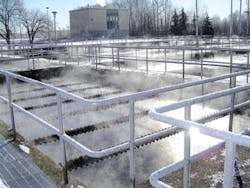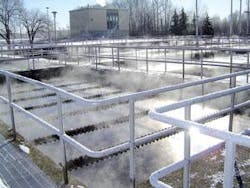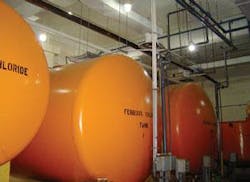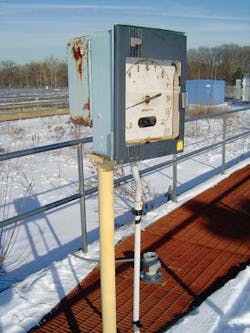Level Measurement System Serves Multiple Roles at WWTP
By Russ Carlson
Wastewater treatment plants must have reliable instrumentation to prevent spills and maintenance headaches. Staff at Flint Water Pollution Control (WPC) of Flint, MI, an 80 mgd facility, recently faced the challenge of monitoring levels on their ferrous chloride tanks and upgrading old, useless flow monitors on the weir channels in the facility’s primary tanks. They had tried a variety of instruments on the ferrous chloride without success, and the old mechanical float/dial gauge flow monitors were rusted out and basically non-functional. Both applications are critical to environmental safety and efficient operation of the plant.
They found a solution for both issues in a single ultrasonic transmitter, the echOsonix from SOR Inc.
The ultrasonic transmitter is designed to handle difficult situations like foam, steam and buildup through three main advances in ultrasonic technology. The product uses low frequency sound to penetrate through conditions like steam and foam that block higher frequencies. The physics of low frequency sound allows it to move through these conditions with little or no signal loss.
The monitor also uses a very high power sound pulse - up to 138dB, or the equivalent of a jet engine on takeoff. By using such a high power signal there is enough sound energy to ensure a return echo when conditions such as a coating or condensate on the sensor block much of the signal.
Finally, the system uses adaptive gain technology. Gain is the sensitivity the unit uses to detect echoes. When it detects an echo weakening due to process conditions that the other features cannot quite overcome, the receiver gain is automatically increased until the return echo can be read reliably. Once the process conditions clear up, the gain is automatically reduced to its previous level to prevent false echoes due to excessive sensitivity.
At Flint WPC, ferrous chloride is used to neutralize phosphates in the influent. Ferrous chloride is highly corrosive to metal and can cause serious health concerns in the event of a spill. Because of this, staff needed a system that was entirely non-metallic. Also, ferrous chloride has a tendency to generate foam when the storage tank is being filled. Other ultrasonic transmitters are confused by this - they either lose track of the process as the foam absorbs the signal or they tend to read the surface of the foam and not the true liquid level.
Different technologies had been tried and nothing was found satisfactory. When staff found out about the new generation technology offered by echOsonix they decided to give it a try. Two units were placed on the storage tanks in 2003 and have operated since without problems. The non-metallic sensor has not exhibited any signs of corrosion damage. It does not require any cleaning maintenance or periodic replacement.
The other major problem the staff was facing involved the weir channels on the primary tanks. The level-to-flow monitors they had were old float devices that fed into a dial gauge. Many of the floats were damaged, corroded or even missing. The dial gauges did not work well, and only one or two of the 10 monitors worked at any given time. Without proper flow control on the weirs, it was very difficult to keep the 10 primary tanks balanced during high flow times. This created problems with plant throughput, process consistency and pump maintenance. The plant needed a reliable solution that could handle steam from the water in the winter, buildup on the sensor face from splashing and frost, turbulence within the channels and reading through foam when it is present.
After the success with the ferrous chloride tanks, the Scada System Automation Supervisor decided to give echOsonix a try in this challenging application. Ten units were installed on the open channel outputs from the primary tanks in February 2005. This was a great time for this installation, as the plant experiences all of the worst-case conditions during the winter. The units were set up and tuned by a local factory-trained sales rep. Manual measurements were taken to verify the operation and accuracy of the units. All 10 units have provided flawless monitoring and control since their installation.
The supervisor at Flint WPC is so pleased with the performance that he has already installed one additional unit on the retention basin used to collect excessive influent during high flow periods. His future plans include putting another on the retention basin, upgrading regional lift station wet wells and river level monitoring, and using the system for measuring bleach levels. WW
About the Author:
Russ Carlson is the Level Product Manager at SOR. He has been with the company for 20 years, working in Design, Manufacturing and Sales Engineering as well as Marketing. Carlson has extensive practical field experience with level instrumentation of all varieties. For further information you may contact him at [email protected] or visit the company’s website at www.echosonix.com.
null



